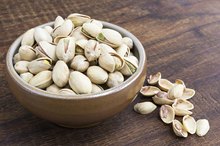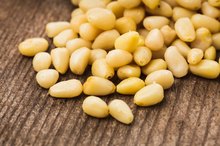What does fact checked mean?
At Healthfully, we strive to deliver objective content that is accurate and up-to-date. Our team periodically reviews articles in order to ensure content quality. The sources cited below consist of evidence from peer-reviewed journals, prominent medical organizations, academic associations, and government data.
The information contained on this site is for informational purposes only, and should not be used as a substitute for the advice of a professional health care provider. Please check with the appropriate physician regarding health questions and concerns. Although we strive to deliver accurate and up-to-date information, no guarantee to that effect is made.
Side Effects of Eating Nuts
Nuts provide health benefits, such as protein, unsaturated fats, fiber, vitamins, minerals, and other micronutrients, but they can also have side effects, mostly in the form of allergic reactions. Peanuts rank third among the most common food allergies in young children, and the most common allergic reaction in older children and adults, according to the University of Chicago Pritzker School of Medicine. Nut allergies cause symptoms from the annoying to the life-threatening. Processed foods that contain nuts and foods manufactured in factories where cross-contamination might occur must label their products.
If you are experiencing serious medical symptoms, seek emergency treatment immediately.
Skin Reactions
Skin reactions account for the most common type of food allergy reactions, according to TeensHealth from Nemours 3. Typical skin reactions include rash, facial swelling, especially around the eyes or mouth, hives, itching, a tingling sensation in the mouth or general redness. Fifty-one percent of people with peanut allergy report facial swelling, also called angioedema, according to the University of Chicago; hives affect 47 percent. Some people develop canker sores -- small, painful mouth ulcers -- when they eat walnuts 2.
Respiratory Reactions
Nuts & Their Negative Effects
Learn More
Typical allergy reactions that affect the respiratory tract include sneezing, runny nose or coughing. Respiratory allergic reaction to nuts can cause also life-threatening side effects. Swelling in the throat and airways can cause shortness of breath, a tight feeling in the throat or wheezing; these symptoms require immediate medical treatment. The University of Chicago reports throat tightness as the most common side effect in a peanut allergy reported by 53 percent. Shortness of breath occurs in 41 percent and wheezing in 29 percent. Breathing in peanut dust or smelling peanuts usually does not set off an allergic reaction, Nemours states. In small or enclosed spaces, like some restaurants and bars where large amounts of peanut-shell cracking takes place, a rare reaction may occur.
- Typical allergy reactions that affect the respiratory tract include sneezing, runny nose or coughing.
- In small or enclosed spaces, like some restaurants and bars where large amounts of peanut-shell cracking takes place, a rare reaction may occur.
Systemic Reactions
At the average of about 14 months, around 75 percent of children with peanut allergies will develop a severe reaction on their first exposure, according to the University of Chicago. Anaphylaxis causes circulatory collapse, with low blood pressure, heart arrhythmias and loss of consciousness. Death can occur without prompt treatment. People with nut allergies should carry an epi-pen, which contains adrenaline, at all times. Administer at the first sign of significant reaction.
- At the average of about 14 months, around 75 percent of children with peanut allergies will develop a severe reaction on their first exposure, according to the University of Chicago.
- Anaphylaxis causes circulatory collapse, with low blood pressure, heart arrhythmias and loss of consciousness.
Gastrointestinal Reactions
Can Pistachio Nuts Cause Diarrhea?
Learn More
Abdominal pain or cramping, diarrhea, nausea and vomiting can also occur as part of an allergic reaction to nuts. Vomiting affects 17 percent of people with a peanut allergy and diarrhea occurs in 6 percent, the University of Chicago states.
Diverticular Disease
People with diverticulosis develop small sacs, called diverticula, in the muscle layer of the intestines. Previously prohibited high-risk foods, like nuts and popcorn that might lodge within the sacs, found some vindication in an 18-year Harvard study of 47,228 male health professionals aged 40 to 75 years. As reported in the August 27, 2008 issue of the Journal of the American Medical Association, neither nuts nor popcorn increased the risk of developing diverticulosis or its complications 4. Researchers could not specifically study how nuts and popcorn affected subjects with established, but undiagnosed, diverticulosis. However, because of the higher risk factor for diverticulosis among the middle-aged and elderly study participants, researchers presumed their findings also applied to established, but asymptomatic diverticulosis. If you have diverticular disease, do not make any dietary changes without first consulting your doctor.
- People with diverticulosis develop small sacs, called diverticula, in the muscle layer of the intestines.
- However, because of the higher risk factor for diverticulosis among the middle-aged and elderly study participants, researchers presumed their findings also applied to established, but asymptomatic diverticulosis.
Related Articles
References
- Linus Pauling Institute: Nuts
- Animated-Teeth: Canker Sores
- TeensHealth from Nemours: Nut Allergy
- Journal of the American Medical Association: Nut, Corn, and Popcorn Consumption and the Incidence of Diverticular Disease
- Cianferoni A, Muraro A. Food-Induced Anaphylaxis. Immunology and allergy clinics of North America. 2012;32(1):165-195. doi:10.1016/j.iac.2011.10.002.
- Jerschow E, Lin RY, Scaperotti MM, Mcginn AP. Fatal Anaphylaxis in the United States, 1999-2010: Temporal Patterns and demographic Associations. Journal of Allergy and Clinical Immunology. 2014;134(6). doi:10.1016/j.jaci.2014.08.018.
- Melville N, Beattie T. Paediatric Allergic Reactions in the Emergency Department: A Review. Emergency Medicine Journal. 2008;25(10):655-658. doi:10.1136/emj.2007.054296.
- Stiefel G, Anagnostou K, Boyle RJ, et al. BSACI Guideline for the Diagnosis and Management of Peanut and Tree Nut Allergy. Clinical & Experimental Allergy. 2017;47(6):719-739. doi:10.1111/cea.12957.
Writer Bio
A registered nurse with more than 25 years of experience in oncology, labor/delivery, neonatal intensive care, infertility and ophthalmology, Sharon Perkins has also coauthored and edited numerous health books for the Wiley "Dummies" series. Perkins also has extensive experience working in home health with medically fragile pediatric patients.









